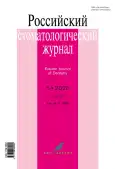Justification of the effectiveness of hirudotherapy in dentistry
- Authors: Abdullaeva A.I.1, Pustovaya E.P.2, Slonova V.M.2, Karnaeva A.S.2, Pilshchikova O.V.2, Gevorkyan A.A.2
-
Affiliations:
- Pirogov Russian National Research Medical University
- Peoples' Friendship University of Russia
- Issue: Vol 24, No 5 (2020)
- Pages: 328-331
- Section: Reviews
- URL: https://journals.rcsi.science/1728-2802/article/view/61040
- DOI: https://doi.org/10.17816/1728-2802-2020-24-5-328-331
- ID: 61040
Cite item
Full Text
Abstract
This article provides a systematic review of studies on the composition of leech saliva secretions, the method of hirudotherapy, and the results of hirudotherapy in complex treatment. The following databases were used to search for the study: Scopus, Web of Science, MedLine, and Global Health. When using known methods of treatment, there is often no stability of results, this is explained by the search for new drugs and methods for treating periodontitis. It is known that the secret of the salivary glands of the medical leech contains more than 100 biologically active substances. The therapeutic effect of hirudotherapy is associated with the mechanical discharge of blood flow and the action of a complex salivary gland secretion of a medical leech. The molecules that exist in leech saliva and are the most studied to date include active substances such as hyaluronidase, hirudin, Kalin, destabilase, bdellins, histamine-like substances, hirustazine, factor XA inhibitor, and collagenase. It is scientifically proven that hirudotherapy leads to a significant improvement in the clinical condition of periodontal tissues, is simple, accessible, and can be recommended for use in the practice of periodontists.
Keywords
Full Text
##article.viewOnOriginalSite##About the authors
A. I. Abdullaeva
Pirogov Russian National Research Medical University
Email: valeri99@bk.ru
Russian Federation, 1, Ostrovityanova street, Moscow, 117997
Elena P. Pustovaya
Peoples' Friendship University of Russia
Author for correspondence.
Email: valeri99@bk.ru
Associate Professor of the Department, Candidate of Medical Sciences
Russian Federation, 6, Miklukho-Maklaya street, Moscow, 117198V. M. Slonova
Peoples' Friendship University of Russia
Email: valeri99@bk.ru
Russian Federation, 6, Miklukho-Maklaya street, Moscow, 117198
A. S. Karnaeva
Peoples' Friendship University of Russia
Email: valeri99@bk.ru
Russian Federation, 6, Miklukho-Maklaya street, Moscow, 117198
O. V. Pilshchikova
Peoples' Friendship University of Russia
Email: valeri99@bk.ru
Russian Federation, 6, Miklukho-Maklaya street, Moscow, 117198
A. A. Gevorkyan
Peoples' Friendship University of Russia
Email: valeri99@bk.ru
Russian Federation, 6, Miklukho-Maklaya street, Moscow, 117198
References
- Karpenko IN, Bulkina NV, Ponukalina EV. Modern ideas about the etiology and pathogenesis of rapidly progressive periodontitis. Arkhiv patologii. 2009;71(1):57–59. (in Russian)
- Munshi Y, Ara I, Rafique H, Ahmad Z. Leeching in the history. A review. Pak J Biol Sci. 2008;11(13):1650–1653. doi: 10.3923/pjbs.2008.1650.1653.
- Tyukin OA, Luk'yanova IE. Girudoterapiya — kachestvo zhizni. In: Luk'yanova IE, editor. Shkola mediko-sotsial'noi reabilitatsii. Sbornik nauchnykh trudov. Moscow: Diona; 2019. P. 82–89. (in Russian)
- Burov M. Lechenie piyavkami. Girudoterapiya. Moscow: Feniks; 2015. 234 p. (in Russian)
- Giannobile WV, Kornman KS, Williams RC. Personalized medicine enters dentistry: what might this mean for clinical practice? J Am Dent Assoc. 2013;144(8):874–876. doi: 10.14219/jada.archive.2013.0200.
- Kraynov SV, Popova AN. Hirudotherapy in dental practice. Colloquium-journal. 2018;(8–2):19–21. (in Russian)
- Porshinsky BS, Saha S, Grossman MD, Beery li PR, Stawicki SA. Clinical uses of the medicinal leech: a practical review. J Postgrad Med. 2011;57(1):65–67. doi: 10.4103/0022-3859.74297.
- Savinov VA. Kompleksnaya girudoterapiya. Moscow: Meditsina; 2008. 258 p. (in Russian)
- Klimovich LV. History and scientific justification of hirudotherapy (literature review). Meditsina neotlozhnykh sostoyanii. 2012;(7–8):46–47. (in Russian)
- Shlykova EA, Selina OB, Primacheva NB. Girudoterapiya, kak effektivnyi metod lecheniya zabolevanii tkanei parodonta. In: Sukisyan AA, editor. Sov-remennyi vzglyad na budushchee nauki. Ufa: Aeterna; 2014. P. 99–102. (in Russian)
- Kruer RM, Barton CA, Roberti G, Gilbert B, McMillian WD. Antimicrobial prophylaxis during Hirudo medicinalis therapy: a multicenter study. J Reconstr Microsurg. 2015;31(3):205–209. doi: 10.1055/s-0034-1395395.
- Gileva OS, Mumcuoglu KY. Hirudotherapy. In: Grassberger M, Sherman RA, editors. Biotherapy-history, principles and practice: a practical guide to the diagnosis and treatment of disease using living organisms. London: Springer Science & Business Media; 2013. Р. 31–76.
- Hildebrandt JP, Lemke S. Small bite, large impact–saliva and salivary molecules in the medicinal leech, Hirudomedicinalis. Naturwissenschaften. 2011;98(12):995–1008. doi: 10.1007/s00114-011-0859-z.
- Singh AP. Medicinal leech therapy (hirudotherapy): a brief overview. Complement Ther Clin Pract. 2010;16(4):213–215. doi: 10.1016/j.ctcp.2009.11.005.
- Liu C, Barkley TW Jr. Medicinal leech therapy: new life for an ancient treatment. Nursing. 2015;45(11):25–31. doi: 10.1097/01.NURSE.0000472561.41030.2d.
- Abdullah S, Dar LM, Rashid A, Tewari A. Hirudotherapy/leech therapy: applications and indications in surgery. Arch Clin Exp Surg. 2012;1(3):172–180. doi: 10.5455/aces.20120402072447.
- Das BK. An overview on hirudotherapy/leech therapy. Ind Res J Pharm Sci. 2014;1:33–45.
- Gronwald W, Bomke J, Maurer T, Domogalla B, Huber F, Schumann F, et al. Structure of the leech protein saratin and characterization of its binding to collagen. J Mol Biol. 2008;381(4):913–927. doi: 10.1016/j.jmb.2008.06.034.
- Herlin C, Bertheuil N, Bekara F, Boissiere F, Sinna R, Chaput B. Leech therapy in flap salvage: systematic review and practical recommendations. Ann Chir Plast Esthet. 2016;62(2):e1–e13. doi: 10.1016/j.anplas.2016.06.004.
- Zaidi SM, Jameel SS, Zaman F, Jilani S, Sultana A, Khan SA. A systematic overview of the medicinal importance of sanguivorous leeches. Altern Med Rev. 2011;16(1):59–65.
- Praded MN, Nikonov GI. Microbiota of medicinal leech. Vestnik veterinarii. 2020;(2):63–72. (in Russian)
- Conley K, Jamal Z, Juergens AL. Leech Bite. In: StatPearls. Treasure Island (FL): StatPearls Publishing; 2020.
- Raffel TR, Dillard JR, Hudson PJ. Field evidence for leech-borne transmission of amphibian Ichthyophonus sp. J Parasitol. 2006;92(1):1256–1264. doi: 10.1645/GE-808R1.1.
- Burgonsky VG, Yurkina AV. Hirudotherapy application in the stomathological practice. Sovremennaya stomatologiya. 2016;(1):7. (in Russian)
- Baranovskii AYu. Lechenie piyavkami. Teoriya i praktika girudoterapii. Moscow: Ves'; 2015. 976 p. (in Russian)
- Vitte J. Human mast cell tryptase in biology and medicine. Mol Immunol. 2015;63(1):18–24. doi: 10.1016/j.molimm.2014.04.001.
Supplementary files






